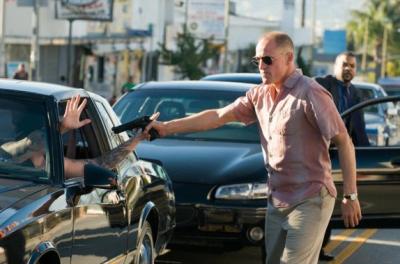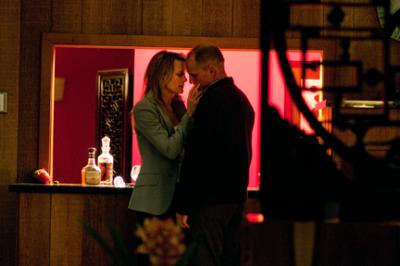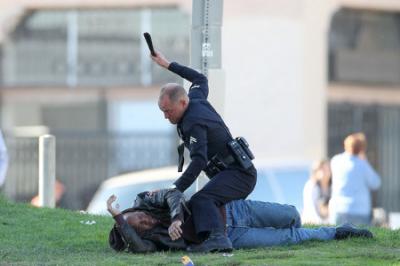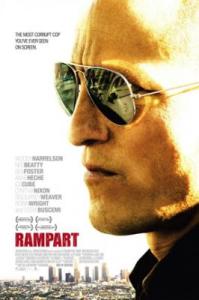By: debbie lynn elias

Woody Harrelson, Oren Moverman and Ben Foster are the perfect filmmaking triumvirate. Many talk about the relationship between Johnny Depp and Tim Burton which, while distinctive and exciting, pales in comparison to the cerebral and emotional intensity of story and film achieved by Harrelson, Moverman and Foster. We saw it with the award winning and acclaimed “The Messenger“, a film written and directed by Moverman and a performance by Harrelson that I didn’t believe could be surpassed. I was wrong, because as LAPD officer Dave Brown, Harrelson soars to heights of emotion and performance beyond imagination. A character rooted in the core belief of love of family and work, and the responsibilities that go with both, while on the surface Dave Brown may appear to be a loose cannon, Harrelson gives him a strength of conviction and strength of heart that explodes with an emotional impact that is visual, visceral and raw, giving us the best performance of Harrelson’s career; absolutely brilliant.
The time is 1990’s and the LAPD is embroiled in what would become known as the “Rampart scandals” – a plethora of reports arising out of misconduct of the anti-gang unit of the Rampart Division. Dave Brown is a lifer cop and LAPD is his life. He lives and breathes the force. Unfortunately, Brown is also a cop whose corruption and personal convictions have spiraled out of control leading him down the dangerous path of not being able to distinguish right from wrong. Brown is highly intelligent. While he graduated law school, he never took the Bar exam, but is at ease with case law recitations to support his conduct or misconduct associated with his police duties. Using his legal knowledge to justify and manipulate his actions, Brown has a level of physical cruelty and abuse to suspects that is at times almost frightening.

But at the end of the day, Brown has his charm, not to mention his daughters and a very interesting living arrangement. Now divorced from sisters Catherine and Barbara, he was at various times married to each, fathering a daughter with each. Rooted in his belief that family is everything and as the patriarch, he must care for his family, the two women now live next door to one another with Dave in a guest house and still making the occasional conjugal visit to Catherine. And on those occasions when she rebuffs his advances, Dave slinks out to the local bars preying on the unsuspecting. Of course that also changes when he becomes the target of a woman who may be on an emotional par with Dave, a defeated-looking and lost criminal defense attorney Linda Fentress. But the time has now come when Dave’s house of cards is crumbling faster than Northridge during an earthquake as Catherine and Barbara want him gone, an investigation into his misconduct at work may lead to him losing his badge and his one alleged ally may be anything but that.
There is no one but Woody Harrelson who could bring Dave Brown to life with this level of gravitas, dynamics, intensity and honesty to character. You never tire of seeing Harrelson or Dave on screen and you wait in anticipation to see what Dave will do next. Harrelson not only draws you into the film, he draws you into Dave’s psyche. One cannot help but admire Dave’s personal conviction. He never wavers from his personal convictions which is a great strength of character point. But beyond that is his love of his daughters. It’s this grounding aspect, and Harrelson’s own experience as a father to daughters, that helped him establish Dave. “I think you approach any character from the things you know, and then the things you don’t know you just have to use imagination. I know that Dave Brown, to me, he loves his family and I love my family. To me, that was a real starting point to start to bond with the character.”

Giving Dave humanity within his inhumanity, Harrelson makes it possible for us to not only root for Dave but for those whose lives he affects, wanting to see life turn around and be the dream that Dave believes his life to be with love and family and no crime. “I don’t think that Dave Brown is all bad. He certainly has his level of charm about him that helps him out, particularly with his family up until things really start to implode. I do think he really does love his family, including his ex wives. What love he has, that’s where he goes. Up until things start to fall in disarray, I think it’s really a Shangri-La experience for him living in between his two ex-wives, who are sisters, and each one has kids…It’s an ironic kind of viewpoint that Dave has.”
Adding to the authenticity of the film, Harrelson did training with LAPD. “It made me feel a lot more affinity with cops, generally. I really liked the guys I was on ride-alongs with. They’re like us. They’re so much more human than I could even have imagined. . .Ultimately I came to respect them and feel like, ‘I could be a cop.’ That was my main issue. I just couldn’t imagine myself as a cop and eventually I could and did.”

Harrelson is also quick to give kudos to Ben Foster. “Ben was very involved in this movie [as a producer], as much as he was involved in “The Messenger” because he was there every single day. For me, if I had a heavy emotional scene, Ben was right next to me the whole time, keeping it raw, keeping other people away from me, making sure it was a clean space. He likes to keep the intense levels of emotionality.”
With Dave being a man trying to be a man and “do man’s work” in a male dominated world, the irony isn’t lost on Moverman’s creation of an all female world into which Dave gravitates for love and acceptance and tolerance. Anne Heche and Cynthia Nixon are perfect complements not only as sisters, but as ex-wives, particularly Heche who brings real depth to Catherine with layers of emotion and feelings toward Dave that buttress Harrelson’s performance. A real treat is Brie Larson as daughter Helen. With a spirit more akin to that of Dave, Larson takes us on a journey with Helen as her eyes open to the world and to her father. It’s actually quite touching and poignant watching her performance.

Providing a little maternal love to Dave is Sigourney Weaver. As top brass/investigator Joan Confrey, Weaver gives Confrey an ambiguity that serves as a catalyst for thought as to underlying events within the LAPD and particularly as to Dave. Is she Dave’s guardian angel or is she sent from hell to bring him down? Similarly, Robin Wright soars as Linda Fentress going toe-to-toe on a physical and emotional par with Harrelson. Also designed to create ambiguity is an undercover IA investigator played by Ice Cube, a role which adds some humor to the film given his inability to “blend” into surveillance of Dave and Dave immediately spotting it.
Not to be overshadowed, veteran Ned Beatty stuns as retired detective Hartshorn. Serving as a department “snitch” for Dave, Hartshorn always seems to mysteriously know what’s happening before it happens, information that he repeatedly funnels to Dave. Why? Beatty’s joviality rivals Harrelson’s charm which sets up yet another fascinating dynamic. And then there’s Ben Foster, with his primary function on RAMPART as producer, at the insistence of Harrelson and Moverman, Foster also has a small but pivotal role as homeless paraplegic “General Terry”, often the target of both Dave’s rage and his kindness. Foster is flawless with his presentation of the paraplegic giving Terry an understated confidence and self-worth in spite of his circumstance.
Key to RAMPART is not only the script by Oren Moverman and James Ellroy, the latter of whom is a staunch supporter of the police and perhaps one of the most knowledgeable writers out there when it comes to police procedures and politics, but also Moverman’s “no rehearsal” style of direction. To Ellroy, a cop can do no wrong. To Moverman, a cop is human, flawed and imperfect and just as accountable to the world as any one of us. So the problem presents of how to present this compelling character study of an imperfect cop without pandering to acceptable protocols of absolution. The answer is to have Woody Harrelson play Dave Brown and to celebrate and showcase the good and the bad of the man – heavy drinking, incessant smoking, racism, defiance to authority, self-justifications, womanizing, love of family and of his daughters, the pride in wanting to make the streets safe for his daughters – while shooting “on the fly” without rehearsal, without blocking, in order to capture the true essence and volatility of emotion.

According to Harrelson, “Oren [Moverman] gives you all the tools and all the help in the world. He is, to me, one of the great directors. . .You may be walking on a tightrope, but there’s the net and the net is Oren. He gives you the parameters – this is where you can move in the scene and you get all these great words to say but you don’t talk to the other actor ahead of time – and you just jump in and you never know what’s gonna happen. He encourages improv so you really have to be listening and facile in the moment. You don’t know where you’re gonna move because it’s not blocked out and Bobby Bukowski (DP) is great because he does this improvisational dance of following you. The camera’s always moving. It’s a pretty exciting way to work and play.”
As comes as no surprise, cinematographer Bobby Bukowski’s work is riveting. With intimate, intense angling thanks to superb hand-held camera work, Bukowski and Moverman create an often surreptitious, fly-on-the-wall, yet in-your-face experience, heightening the excitement, angst and adrenalin. And although the audience has that sensory experience, for Harrelson, “I usually know where that camera is. I’m pretty confident where that camera is although there were times I’d be surprised that the second camera was over somewhere I didn’t see it. It’s an incredible style. He doesn’t do your typical ‘Okay, here’s the wide shot, and here’s the over, and here’s the close’. He doesn’t shoot that way. He knows what he wants and he gets wild angles. I feel like they’re a real dream team – Oren and Bobby. There’s a real level of unpredictability of what the camera’s going to do.” And that unpredictability translates into pure emotion on screen.

The showpiece of Bukowski’s work, and possibly Harrelson’s performance, is Dave’s descent into hell during an evening’s debauchery. Lit in myriads of red tones, the scene is a feverish and frenzied hallucinogenic apex of Dave’s breakdown where there is now no longer right and wrong, only chaos and confusion, and whether he emerges from that hell come daylight is for us to wait and see. The most visceral and visually powerful sequence in the film, it also has the loudest voice.
I asked Harrelson about the magic that is he, Moverman and Foster. “We all care a lot. On any given day we just want to make that scene as great as it can be with the most emotional impact and in the long run, we just want that movie to be as good as it can be. I think us caring; and we love each other a lot.”
Life and death, sanity and insanity, humanity and inhumanity. The courage to stand on one’s convictions. Visceral white hot emotion fueled by a frenzied fire. This is RAMPART.
Dave Brown – Woody Harrelson
Catherine – Anne Heche
Barbara – Cynthia Nixon
Helen – Brie Larson
Joan Confrey – Sigourney Weaver
Linda Fentress – Robin Wright
Directed by Oren Moverman. Written by Moverman and James Ellroy.











